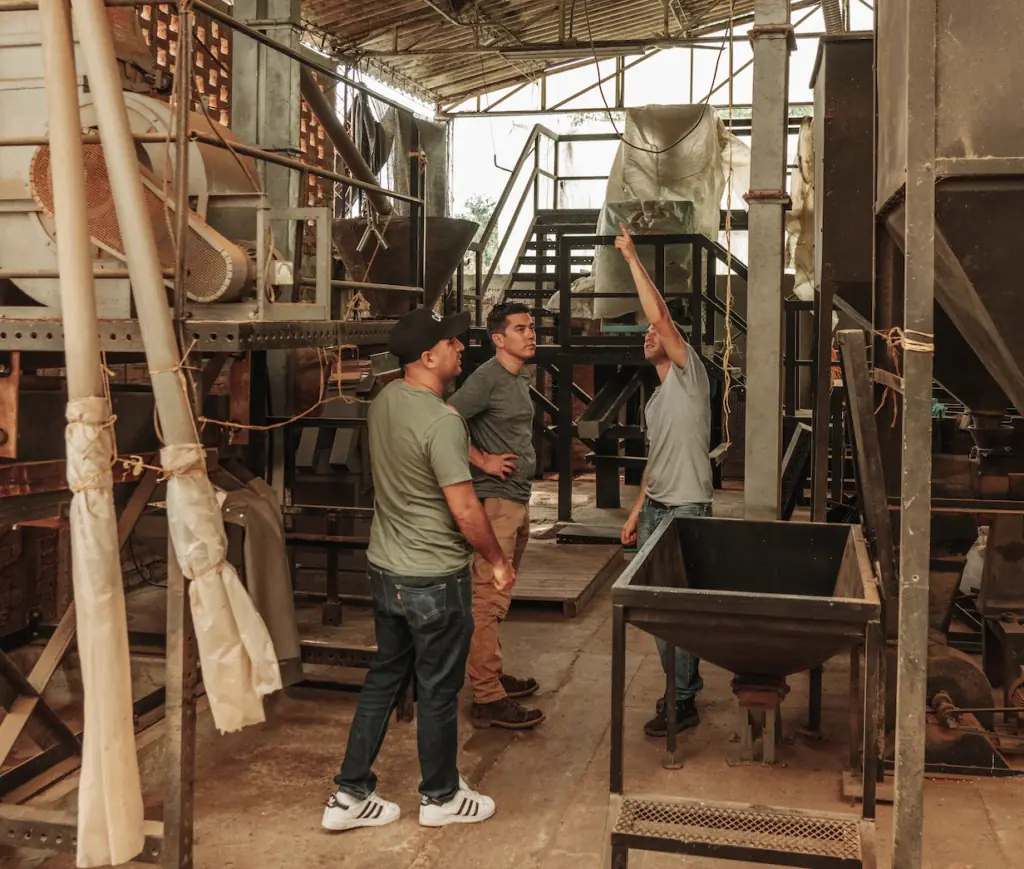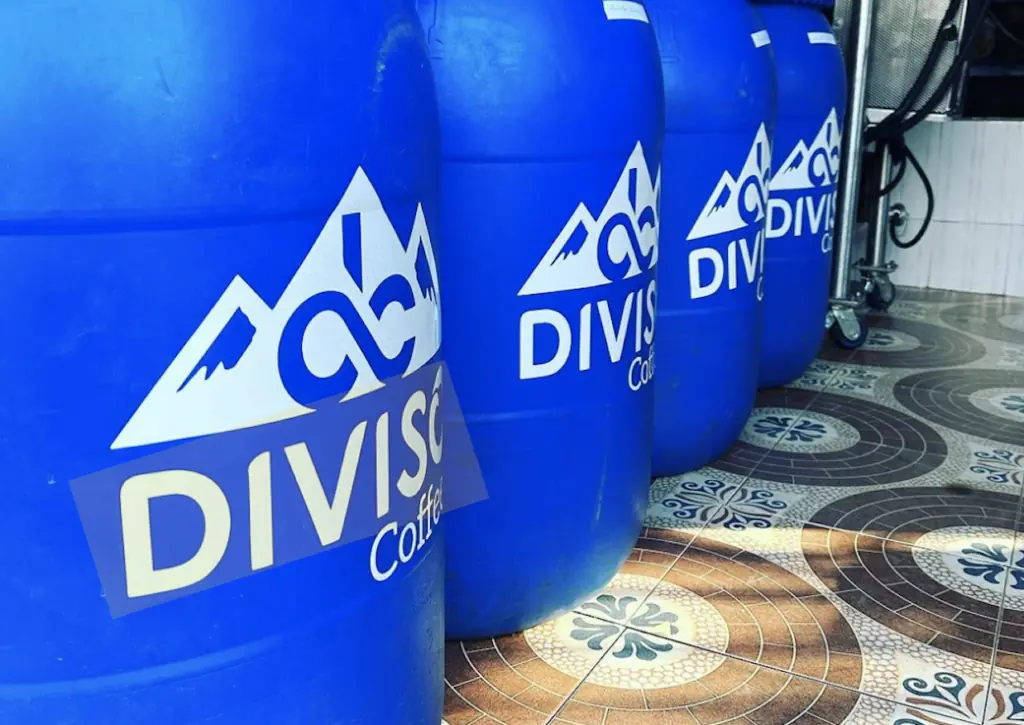
Welcome sign at Finca El Divisi in Colombia’s Huila Department. Courtesy of Chromatic Coffee.
I’ll start with a familiar story. Around 2004, a Panama coffee farmer, Price Peterson, found a field of coffee trees growing on his property that was different in appearance from other trees. He entered the coffee from those trees as a separate lot in the 2004 Best of Panama green coffee competition, and that coffee, competing as the “Geisha” variety of Arabica, blew away that year’s competition, that year’s coffees from any other place in the world, and everyone who tasted it.
Coffee from this newly rediscovered variety tasted startlingly complex and different and continues to taste that way even when planted elsewhere, so long as the seedlings represent the authentic Geisha as rediscovered in Panama, and growing conditions are appropriate.
This is not the place to go into the confusion and debate that has developed over the past decade around Geisha, from debates about how to spell the name to Geishas that don’t taste like Geishas. What is important for this report is the fact that a previously unrecognized variety of Arabica coffee was found simply growing in a Panama coffee field, and that previously unrecognized variety went on to change the world of specialty coffee.
True, Geisha/Gesha was subsequently traced back through Costa Rica to Kenya and Tanzania to a specific region in Ethiopia. Nevertheless, the possibility remains that there could be another Geisha growing in someone else’s field of anonymous trees, another botanical and sensory gold mine waiting to be discovered.
Perhaps it is that possibility, the potential emergence of another game-changing variety of Arabica from anonymity, that has encouraged attention to a cluster of new coffee varieties that have popped up over the past three or four years on roaster websites and in our reviews. In particular, we have heard a lot about Pink Bourbon, Chiroso and Sidra, all coffee varieties that are new and relatively unfamiliar to most fine coffee enthusiasts, and all apparently first selected from fields in Colombia or neighboring Ecuador.
New Names and Claims
For this month’s report, we sample some of these relatively new varieties. Do they actually taste that different or superior to more familiar varieties like Typica, Bourbon, Caturra, Castillo or Catuai, varieties that typically make up the coffee samples from Colombia and Central America we test at Coffee Review? How well do these newer varieties stand up when compared to samples from that sensory powerhouse Geisha? What, roughly, can consumers expect when they buy a coffee from trees of one of these relatively new varieties?

Working the covered drying beds at Finca El Diviso in Colombia. Courtesy of Chromatic Coffee.
We were particularly interested in tasting those varieties that apparently were selected informally and turned out to taste different or exciting enough for other farmers to plant them and help establish them as relatively stable varieties. All three have created some internet buzz. Again, they are Sidra (sometimes called Sidra Bourbon), Pink Bourbon (note it is pink Bourbon, not yellow or red), and Chiroso (sometimes called Chiroso Caturra). We were able to source 14 samples said to be produced from trees of these varieties.
Other Newcomers
We also tested a smattering of coffees from other varieties that are not typically grown in Ecuador, Colombia or Central America, but which were recently brought in and established on farms there. They include the Ethiopian Wush Wush variety (a popular choice with 10 samples), the Kenyan SL28, and the fascinating Java, a variety first established in Java in the early 19th century with seed brought directly from Ethiopia, then refined by geneticists in Cameroon before rerelease as a stable (and often outstanding) variety under the Java name in the 1980s. This month we review a fine Java grown in Colombia at Finca El Roble by Jairo Ivan Lopez and Corvus Coffee, rating it at 95 for its clean, intense sweetness and its cocoa and rich berry notes suggesting the similar flavor complex in some Geisha profiles.

Processing coffee cherries at Finca El Roble in Colombia’s Quindio Department. Courtesy of Corvus Coffee.
We also tested single samples from a half-dozen other varieties, including Centroamericano and Milenio, both deliberate crosses between a tough, disease-resistant hybrid (Sarchimor) and an Ethiopia variety admired for its distinctive cup character (Sudan Rume). The goal with such F-1 crosses, as they are called, is to produce a variety robust enough to stand up to the stress of climate change while delivering the sensory complexity of fine Ethiopia coffees. In other words, a win-win. Centroamericano and Milenio were part of the first wave of F1 hybrid varieties created by a consortium including French research institute CIRAD, a regional network of national coffee institutes in Central America (PROMECAFE), and the tropical agricultural research and higher education center CATIE. F1 hybrid varieties are still relatively new in coffee agriculture. Only a handful have become commercially available to farmers in the past 15 years, including the Milenio reviewed here, produced by the Las Lajas micro-mill in Costa Rica and reviewed at 92 as sourced and roasted by Seattle’s Fulcrum Coffee Roasters.
Processing Hijinks Make Evaluation Challenging
Of the three emerging varieties we particularly focus on, Pink Bourbon has attracted the most internet praise. Chiroso and Sidra also have received good press, but not as much of it.
Our sampling of roasted coffees produced by these three newly publicized varieties was relatively modest in number (a total of 15). And evaluating their potential in the cup was complicated by the fact that some of these samples were processed by experimental anaerobic processing methods deliberately designed to intensify their complexity and distinction.

Fermentation barrels at Finca El Diviso where many anaerobic coffees are processed. Courtesy of Chromatic Coffee.
So, it’s difficult to tell how much of the surprise and excitement displayed by some of these samples comes from the new, unfamiliar tree variety and how much from the application of ingenious new processing methods. However, I personally have concluded that the often pleasing complexity and juicy structure of the best of these samples are mainly associated with their innate character. In other words, in my opinion (mine alone), the processing wrinkles may have intensified complexity and intensity, but the best of these samples were intrinsically impressive.
The New Variety Scorecard
Of the varieties we tested and focused on, Sidra considerably surpassed the others in average ratings, including both the Ethiopian Wush Wush and the much-admired Pink Bourbon and Chiroso. Given the relative few samples of each variety, however, it could just be the luck of the Sidra. Remember that we cup our samples blind; we have no idea of the identity of a sample at the moment we cup it.
- Sidra, seven samples, average rating 93, high 95 low 91
- Chiroso, five samples, average rating 89, high 94 low 84
- Pink Bourbon, three samples, average rating 90, high 92 low 89
- (For general comparison, Wush Wush 10 samples, average rating 88, high 93 low 81)
Three of the Sidra samples in particular — the top-rated Chromatic Coffee Colombia Finca El Diviso, the Euphora Coffee Ecuador Sidra, and the Kakalove Colombia Las Flores Sidra, all rated 95 — were particularly impressive, and all quite different, though alike in their thrilling floral and fruit intricacy and complex, nuanced layering of foundational tastes. The Chromatic Finca El Diviso is jammier, deeper, more fruit- and chocolate-toned than the others. The Euphora Ecuador Sidra is also deep, but floral, with a particularly exciting bright acidity that shimmers at the heart of the profile. The Kakalove Las Flores Sidra is a bit quieter, more balanced and complete than the others, with a characteristic Geisha-style layering of flowers and cocoa.
Typica-Bourbon Hybrids? Nope
The most prevalent explanation for why these three varieties are surprising and exceptional in the cup runs along these lines: They are complex and exciting because they are spontaneous hybrids of Bourbon and Typica and they embody the best of both of these varieties. Some internet accounts particularly emphasize the “better because they’re both” argument.
The pride New World farmers must take in celebrating the special virtues of new varieties that seem to brilliantly fuse the character of the two fundamental pillars of Latin American coffee, Typica and Bourbon, is understandable.
However, if genetic evidence is to be believed (and what else might we believe?), we are looking at three more examples of “Ethiopian escapees.” In other words, three more versions of the Geisha story. According to Christophe Montagnon, leading tropical agriculture geneticist and head of coffee genetics research firm RD2 Vision, Sidra, Pink Bourbon and Chiroso all have no relationship whatsoever to either Bourbon or Typica. They are part of a “Core Ethiopia” genetic group, consisting of Ethiopian “landrace” varieties selected for good performance by farmers.
Which farmers, and where did they do that selecting? The trees are not telling, and so far, no one has been able to trace any of these three varieties back through history, as was possible with Geisha/Gesha. So, we have the unraveling of this mystery to look forward to. But wherever the selection happened, most likely farmers or their technical advisors did the selecting, so I say score one for the coffee grassroots.
Two More Varieties: Chiroso, SL28
We review one Chiroso from Taiwan roaster at 94, the GK Coffee Colombia El Roble Chiroso Washed, which impressed with its delicacy, the way its flowers edged toward herb, displaying an engagingly fresh, gardeny character. The highest rated coffee in this month’s report not grown from Ethiopian-related plant material is the 94-point Equator Coffee Guatemala El Injerto SL28, in which the pungent, resinous note characteristic of the great Kenya SL28 variety sweetens and rounds beautifully in a mango and lavender direction.

Coffees drying at Finca El Injerto in Guatemala’s Huehuetenango Department. Courtesy of Equator Coffee.
Thanks and a Deeper Dive on Coffee Variety
Special thanks to Miguel Meza of Paradise Roasters and Christophe Montagnon of RD2 Vision for their generous advice on this report.
Senior Editor Kim Westerman and Associate Editor Jason Sarley co-cupped all samples and contributed to review language and ratings.
For more on coffee variety, I recommend the following resources:
Chris Kornman, Daily Coffee News, “The Coffee Roaster’s Complete Guide to Coffee Varieties and Cultivars”. Lucid and thorough.
Christophe Montagnon, “Arabica Coffee Cultivars Wheel” and associated materials . Authoritative and scholarly.
World Coffee Research’s “Coffee Varieties Catalog”. Meticulous and easy to access.
Or those muscular readers not afraid of heavy books can consult the varieties chapter in my recently published volume 21st Century Coffee: A Guide.










